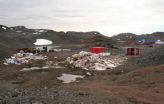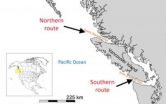(Press-News.org) A natural trigger that enables stem cells to become any cell-type in the body has been discovered by scientists.
Researchers have identified a protein that kick-starts the process by which stem cells can develop to into different cells in the body, for instance liver or brain cells.
Their discovery could help scientists improve techniques enabling them to turn stem cells into other cell types in the laboratory. These could then be used to test drugs or help create therapies for degenerative conditions such as Parkinson's disease, motor neurone disease, multiple sclerosis and liver disease.
Scientists from the Medical Research Council Centre for Regenerative Medicine at the University of Edinburgh, who studied embryonic stem cells in mice, also developed a technique enabling them to highlight the presence of the key protein – Tcf15 – in the cells.
This means that researchers can identify which cells have the protein and watch how it affects stem cells in real time to gain a better understanding of how it works.
The study, published in the journal Cell Reports, was funded by the Wellcome Trust and the Biotechnology and Biological Sciences Research Council,
Dr Sally Lowell, from the MRC Centre for Regenerative Medicine at the University of Edinburgh, said: "This gives us better insight into the crucially important first step stem cells take to differentiate into other cell types. Understanding how and when this happens could help to improve the way in which we are able to control this process."
Researchers pinpointed the protein by looking at how some stem cells are naturally prevented from specialising into other cell types.
They found two sets of proteins, one of which binds to the other blocking them from carrying out their various functions.
They were then able to screen the blocked proteins to find out which ones would enable stem cells to differentiate.
### END
Key protein revealed as trigger for stem cell development
A natural trigger that enables stem cells to become any cell-type in the body has been discovered by scientists
2013-02-07
ELSE PRESS RELEASES FROM THIS DATE:
How a fall in duck hunting is shooting a financial hole into conservation efforts
2013-02-07
The annual duck hunting season in the United States is traditionally big business, but while bird numbers are rising faster than they have for decades, the number of hunters continues to fall. Far from being good news for ducks a new study in the Wildlife Society Bulletin shows how the loss of revenue from 'duck stamps' could result in millions of lost dollars for vital conservation work.
"The last 15 years have brought hunting opportunities not seen since the turn of the last century," said Dr Mark Vrtiska from Nebraska Game and Parks Commission. "The waterfowl population ...
Information Technology improves patient care and increases privacy, MU informatics expert says
2013-02-07
The federal government invested more than $25 billion in health information technology (IT) as a result of the American Reinvestment and Recovery Act; yet, little is known about how IT applications improve patient safety and protect their privacy. Now, a University of Missouri nursing informatics expert suggests that sophisticated IT leads to more robust and integrated communication strategies among clinical staff, which allows staff to more efficiently coordinate care and better protect patient privacy.
Greg Alexander, an associate professor in the MU Sinclair School ...
Waste dump at the end of the world
2013-02-07
This press release is available in German.
(Jena) On their mission to the moon in 1969 the Americans Neil Armstrong and Buzz Aldrin created arguably the most famous footprints ever. Since the time the astronauts of the Apollo 11 Mission stepped onto the surface of our satellite their footprints remain almost unchanged. And as no breath of wind will ever be able to blow them away they will be visible forever.
Not quite so old but equally 'immortal' are many traces that have been left behind by humans at the South Pole of the Earth. This is the result of a report ...
Lancet Oncology: Long-term side-effects of targeted therapies in pediatric cancer patients
2013-02-07
A University of Colorado Cancer Center review published this week in the journal Lancet Oncology describes possible long-term side-effects of new, targeted therapies in pediatric cancer patients: what we don't know may hurt us.
"As pediatricians who treat kids with cancer, we expect the side-effects of traditional chemotherapies: low white blood count, infections, even long-term heart trouble or infertility. But there's the impression that these new, molecularly targeted agents are much less toxic. That may be true, especially in adult patients, but until we have more ...
Poll: Americans back climate change regulation, not taxes
2013-02-07
DURHAM, N.C. -- Now that President Obama has put climate change back on the table in his second inaugural address, a new national poll finds growing public support for regulating greenhouse gas emissions and requiring utilities to switch to lower-carbon fuel sources.
The percentage of Americans who think climate change is occurring has rebounded, according to the Duke University national online survey, and is at its highest level since 2006. The study also finds that while Americans support regulating greenhouse gas emissions, they do not favor market-based approaches ...
Scientists discover how the world's saltiest pond gets its salt
2013-02-07
VIDEO:
Antarctica's Don Juan Pond, the world's saltiest body of water, needs its salt to keep from freezing into oblivion. Scientists had assumed that the saltwater brine that sustains the pond...
Click here for more information.
PROVIDENCE, R.I. [Brown University] — Antarctica's Don Juan Pond might be the unlikeliest body of water on Earth. Situated in the frigid McMurdo Dry Valleys, only the pond's high salt content — by far the highest of any body of water on the planet — ...
Subcortical damage is 'primary cause' of neurological deficits after 'awake craniotomy'
2013-02-07
Philadelphia, Pa. (February 7, 2013) – Injury to the subcortical structures of the inner brain is a major contributor to worsening neurological abnormalities after "awake craniotomy" for brain tumors, reports a study in the February issue of Neurosurgery, official journal of the Congress of Neurological Surgeons. The journal is published by Lippincott Williams & Wilkins, a part of Wolters Kluwer Health.
During a procedure intended to protect critical functional areas in the outer brain (cortex), damage to subcortical areas—which may be detectable on MRI scans—is a major ...
No increase in brain aneurysm rupture risk during pregnancy and delivery
2013-02-07
Philadelphia, Pa. (February 7, 2013) – For women with aneurysms involving the brain blood vessels, pregnancy and delivery don't appear to increase the risk of aneurysm rupture, reports a paper in the February issue of Neurosurgery, official journal of the Congress of Neurological Surgeons. The journal is published by Lippincott Williams & Wilkins, a part of Wolters Kluwer Health.
The study also finds that women with known, unruptured aneurysms have a very high rate of cesarean delivery—which isn't supported by evidence and "may not be necessary," according to Dr. Brian ...
NASA sees the sun produce 2 CMEs
2013-02-07
In the evening of Feb. 5, 2013, the sun erupted with two coronal mass ejections or CMEs that may glance near-Earth space. Experimental NASA research models, based on observations from the Solar Terrestrial Relations Observatory (STEREO) and ESA/NASA's Solar and Heliospheric Observatory, show that the first CME began at 7 p.m. EST and left the sun at speeds of around 750 miles per second. The second CME began at 10:36 p.m. EST and left the sun at speeds of around 350 miles per second. Historically, CMEs of this speed and direction have been benign.
Not to be confused with ...
Animal magnetism: First evidence that magnetism helps salmon find home
2013-02-07
When migrating, sockeye salmon typically swim up to 4,000 miles into the ocean and then, years later, navigate back to the upstream reaches of the rivers in which they were born to spawn their young. Scientists, the fishing community and lay people have long wondered how salmon find their way to their home rivers over such epic distances.
How do they do that?
A new study, published in this week's issue of Current Biology and partly funded by the National Science Foundation, suggests that salmon find their home rivers by sensing the rivers' unique magnetic signature. ...
LAST 30 PRESS RELEASES:
University of Oklahoma researcher awarded funding to pursue AI-powered material design
Exploring how the visual system recovers following injury
Support for parents with infants at pediatric check-ups leads to better reading and math skills in elementary school
Kids’ behavioral health is a growing share of family health costs
Day & night: Cancer disrupts the brain’s natural rhythm
COVID-19 vaccination significantly reduces risk to pregnant women and baby
The role of vaccination in maternal and perinatal outcomes associated with COVID-19 in pregnancy
Mayo Clinic smartwatch system helps parents shorten and defuse children's severe tantrums early
Behavioral health spending spikes to 40% of all children’s health expenditures, nearly doubling in a decade
Digital cognitive behavioral treatment for generalized anxiety disorder
Expenditures for pediatric behavioral health care over time and estimated family financial burden
Air conditioning in nursing homes and mortality during extreme heat
The Alps to lose a record number of glaciers in the next decade
What makes a good proton conductor?
New science reporting guide published for journalists in Bulgaria
New international study reveals major survival gaps among children with cancer
New science reporting guide published for journalists in Turkey
Scientists develop a smarter mRNA therapy that knows which cells to target
Neuroanatomy-informed brain–machine hybrid intelligence for robust acoustic target detection
Eight SwRI hydrogen projects funded by ENERGYWERX
The Lundquist Institute and its start-up company Vitalex Biosciences Announces Strategic Advancement of Second-Generation fungal Vaccine VXV-01 through Phase 1 Trials under $40 Million Competitive Con
Fine particles in pollution are associated with early signs of autoimmune disease
Review article | Towards a Global Ground-Based Earth Observatory (GGBEO): Leveraging existing systems and networks
Penn and UMich create world’s smallest programmable, autonomous robots
Cleveland researchers launch first major study to address ‘hidden performance killer’ in athletes
To connect across politics, try saying what you oppose
Modulating key interaction prevents virus from entering cells
Project explores barriers to NHS career progression facing international medical graduates
Jeonbuk National University researchers explore the impact of different seasonings on the flavor perception of Doenjang soup
Two Keck Medicine of USC Hospitals named Leapfrog Top Teaching Hospitals
[Press-News.org] Key protein revealed as trigger for stem cell developmentA natural trigger that enables stem cells to become any cell-type in the body has been discovered by scientists


